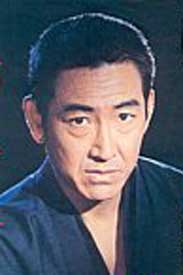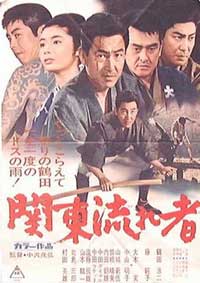Kanto nagare-mono (The Drifters, Toei, 1965) written & directed by Shigehiro Ozawa stars Koji Tsuruta as the chivalrous gambler Seijiro Oya & Junko Fuji as a late 19th Century feminist & daughter of a cruel yakuza oyabun (gangster boss). Sangoro Bato is a tough guy from a coolie gang who pits himself against the chivalrous gambler, as both men love the same geisha, Oshige. But Sangoro & Seijiro become friends after a while & helps Seijiro start a construction business, ceasing to be yakuza.
The film opens with a kendo scene of martial artists fighting with shinai (bamboo swords) followed by a folk dance celebrating Seijiro Oya's victory in the dojo. Though disowned, Seijiro was of a proud samurai family.
Fuji Junko is Osato, an anti-prostitution militant. She wears hakama (samurai trousers) behaving boyishly. Like feminists of most societies, she is stoned & insulted for her efforts, but Seijiro steps in to protect her. It turns out that the militant's own father is a gangster boss who runs a prostitution ring.
Junko is frankly a bit too whiny in this role, despite the character's feminist posturing; the character is no match for her captivating role in the Red Peony Gambler series. But in an unexpected plot twist, her evil dad gives up his brothels because of his daughter.
Sangoro Bato takes over the construction business formerly controlled by the evil gang, & he marries Oshige although, alas, she was more deeply in love with Seijiro. In spring of 1890 under Sangoro's leadership, construction begins on a new Meiji railroad. Just as things seem to be going pretty good for Sangoro, it all falls apart when gangsters bomb his labor headquarters, injuring Oshige. Later Sangoro is murdered on the road, Seijiro's sense of justice means he must revert to his formerly violent yakuza ways.
 There are two great yakuza folk songs on the soundtrack, the second occurring during Seijiro's march to raid the gangster headquarters. He begins his carnage with a gun, but eventually gets a sword for a more classic climax. He takes gunshot wounds but keeps fighting. As his efforts are culminating in victory, Osato pleads for her evil father's life, & the story goes against form in that the bad guy is indeed spared. There are two great yakuza folk songs on the soundtrack, the second occurring during Seijiro's march to raid the gangster headquarters. He begins his carnage with a gun, but eventually gets a sword for a more classic climax. He takes gunshot wounds but keeps fighting. As his efforts are culminating in victory, Osato pleads for her evil father's life, & the story goes against form in that the bad guy is indeed spared.
Kanto yakuza-mono (Riot in Tokyo, Toei, 1964) is also directed by Shigehiro Ozawa, a specialist in chivalrous yakuza-eiga of the 1960s & early 70s. His best work in this area would include episodes of the Bakuchi-uchi Gambling House series, though he's far better remembered for directing Shinichi Chiba in the decidedly non-chivalrous Streetfighter films & similarly "grimy" action tales which arose after the craze for chivalrous gamblers had faded away.
This is another star vehicle for Koji Tsuruta & Junko Fuji, with support performances from Hideo Murata, Yukiko Ninomiya, Minoru Oki, Shingo Yamashiro, Kunio Kaga, & Tetsuro Tamba.
Such films commonly end with a yakuza folksong, but Riot in Tokyo incorporates several songs by three singers, full of minor notes & the deep tragedy of the gambler's world.
The tale opens in 1918, a year of rice riots, & takes place mostly in Tokyo. Koji Tsuruta's twitching, agonized face & soulful eyes make him the very emblem of sadness. "Living is harder than dying," he says before heading off on the raid in the film's last reel. Tetsura Tamba & Koji duel beautifully in that final scene. Koji survives if barely; Tamba commits harakiri in front of old samurai armor.
Kanto hatashijyo (Dark Victory, Toei, 1965) is another Shigehiro Ozawa "Kanto" film featuring Koji Tsuruta as a chivalrous gambler & Junko Fuji this time as a blinded women workers organizer, with supporting performances from Minoru Oki, Shingo Yamashiro, Hiroshi Nawa, & Hideo Murata as the good labor boss.
Set in 1920s, this yakuza-eiga is very good of kind, with the conventional genre characteristics given good context. Unfolding slowly as ninkyo or chivalry style of yakuza-eiga required, only the final reel is genuinely action-packed, & hoo golly. It's a spectacular finale with fifty men armed with dynamite & aggressive mouths versus six-hundred with swords & high powered rifles. Don't vote the underdog out.
copyright © by Paghat the Ratgirl
|

 There are two great yakuza folk songs on the soundtrack, the second occurring during Seijiro's march to raid the gangster headquarters. He begins his carnage with a gun, but eventually gets a sword for a more classic climax. He takes gunshot wounds but keeps fighting. As his efforts are culminating in victory, Osato pleads for her evil father's life, & the story goes against form in that the bad guy is indeed spared.
There are two great yakuza folk songs on the soundtrack, the second occurring during Seijiro's march to raid the gangster headquarters. He begins his carnage with a gun, but eventually gets a sword for a more classic climax. He takes gunshot wounds but keeps fighting. As his efforts are culminating in victory, Osato pleads for her evil father's life, & the story goes against form in that the bad guy is indeed spared.